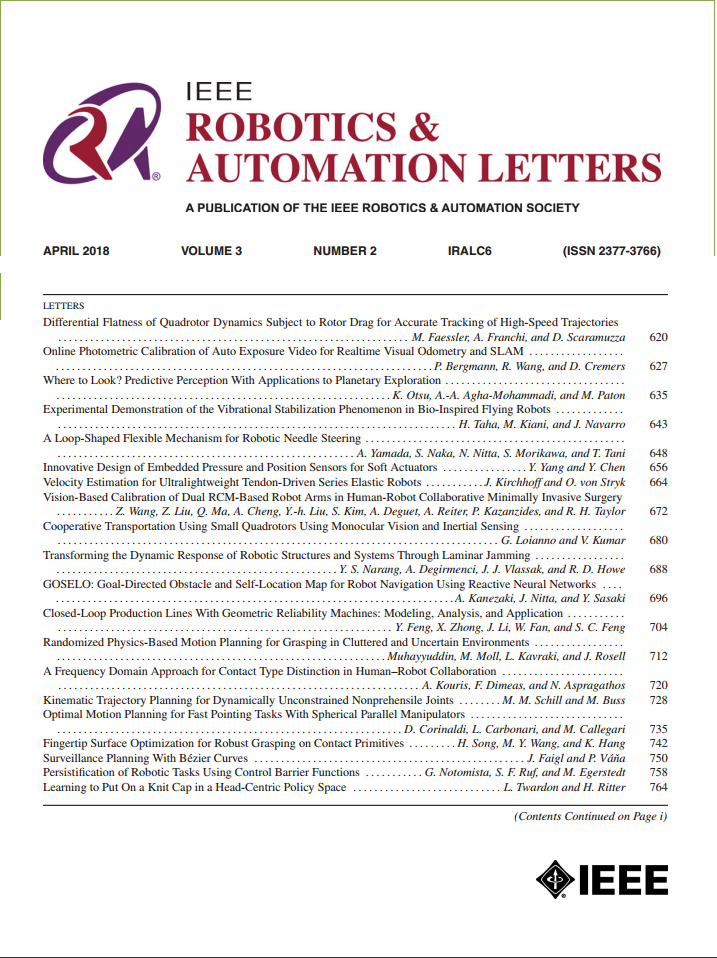Online Motion Generation via Tangential Sampling-Based MPC Around Nonconvex Obstacles
IF 4.6
2区 计算机科学
Q2 ROBOTICS
引用次数: 0
Abstract
Collision-free motion planning has a well-established research history, but the majority of studies have been centered around Euclidean space and conducted offline. The primary challenge in online motion planning lies in circumventing local minima, which become more pronounced in configuration space. We propose an online method for generating collision-free motion in configuration space that effectively avoids local minima. Our approach decomposes the optimal velocity into nominal and tangential components, with the tangential velocity optimized to facilitate escape from local minima. The tangential velocity is defined in the tangential space, with its normal direction determined by the gradient of the nearest distance between the robot and obstacles, relative to the robot's states. Direct optimization of the tangential velocity is challenging due to its dependence on varying tangent spaces. To address this, we represent the tangential velocity using the orthogonal basis of the tangent space, decoupling it from the varying tangent space. This allows explicit optimization of the tangential velocity by optimizing its components. Additionally, we introduce a warm-start operator in the tangent space to ensure the consistency and convergence. Furthermore, we propose a dynamic weight based on proximity to local minima to balance the tangential and nominal velocities, forming the optimal velocity. The effectiveness of our approach in avoiding local minima is validated through simulations and physical experiments.基于切线采样的MPC在非凸障碍物周围的在线运动生成
无碰撞运动规划的研究历史悠久,但大多数研究都是围绕欧几里得空间进行的,并且是离线进行的。在线运动规划的主要挑战在于规避局部最小值,这在构型空间中变得更加明显。提出了一种在构型空间中生成无碰撞运动的在线方法,有效地避免了局部极小值。我们的方法将最佳速度分解为标称和切向分量,切向速度优化以方便从局部最小值中逃脱。切向速度在切向空间中定义,其法线方向由机器人与障碍物之间最近距离相对于机器人状态的梯度决定。切向速度的直接优化是具有挑战性的,因为它依赖于变化的切向空间。为了解决这个问题,我们使用正切空间的正交基来表示切向速度,将其与变化的正切空间解耦。这允许通过优化其分量来显式优化切向速度。此外,我们在切空间中引入热启动算子以保证一致性和收敛性。此外,我们提出了一个基于接近局部最小值的动态权重来平衡切向速度和标称速度,形成最优速度。通过仿真和物理实验验证了该方法在避免局部最小值方面的有效性。
本文章由计算机程序翻译,如有差异,请以英文原文为准。
求助全文
约1分钟内获得全文
求助全文
来源期刊

IEEE Robotics and Automation Letters
Computer Science-Computer Science Applications
CiteScore
9.60
自引率
15.40%
发文量
1428
期刊介绍:
The scope of this journal is to publish peer-reviewed articles that provide a timely and concise account of innovative research ideas and application results, reporting significant theoretical findings and application case studies in areas of robotics and automation.
 求助内容:
求助内容: 应助结果提醒方式:
应助结果提醒方式:


